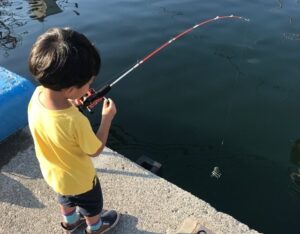Snakehead Fishing in Japan
For many of you, Snakehead is one of the typical target fish only in south east Asian countries. But, actually, there is snakehead in Japan, and it is one of the well known (not really popular) target fish of lure fishing.
In this article, I will introduce the snakehead fishing in Japan, after we review the details of the species.
Species
A typical snakehead species ( Channidae family) has a long body, with long dorsal fins, a large mouth and large sharp teeth. As the name represents, the impression of it is like a snake. In addition to its physical characteristics, the body colors or the patterns on the body are very unique among fish, which gives you an additional snake-like feeling.
Under the Channidae family, there are 2 extant genera, Channa genus and Parachanna genus. Channa genus inhabit Asia, and Parachanna are native to tropical areas in the African continent. Now we know that what we imagine as an Asian snakehead is a species of Channa.
The Channa genus has 51 recognized species.
All 51 species under the Channa genus are well shown in this video.
Among these species, these 5 are said to grow over 1 m:
C. argus (Northern snakehead), C. barca (Barca snakehead), C. marulius (Bullseye snakehead), C. micropeltes (Giant snakehead), and C. striata (Striped snakehead).
The Northern snakehead (Channa argus) is the one we will see as a target fish in Japan. It is native in middle and northern China, and settled into Japan.
Though I know other large snakehead species are not relevant to Japanese fishing, I will briefly introduce the rest of 4 species for my fish lover friends.
Barca snakehead (Channa barca) is living in northern India and Bangladesh. For its rarity and unique pattern, it is valued highly by aquarists, while its adult size over 1 m is not suitable for normal aquariums.
Bullseye snakehead is seen in south Asia. According to the genetic study of 2017, Bullseye snakehead is consisted by three subspecies: C. pseudomarulius (south Asia), C. aurolineata (Myammar and Mae Khlong river), C. auroflammea (Mekong river).
Giant snakehead is the largest species in this genus. In some areas, this is a very popular fish as a food source, called Toman. It is the trophy fish we see often in the fishing results of southeast Asian fishing trips. This fish’s clear lines on its body give very strong impressions.
Striped snakehead is living in south east Asia. Sometimes, it is called the common snakehead, too. It dwells as a native species, from India in the west to Xiamen of China in the east, and Indonesia in the southward.
As a matter of fact, in the late 2010’s, there were more studies published about species. And there may be some subspecies (or species) to be defined, in the future. This shows that the classification is not entirely well understood in these inhabiting areas, and it is leading the confusion in common names of snakehead species.
Coming back to Japan’s target fish, the Northern snakehead (Channa argus).
It distributes in freshwaters in Japan, while it originally dwells in the waters in China, Korea and far east Russia. Distinguishing characteristics of this fish from other snakehead species are in coloration. It has patches of darker brown, on the sides and back, with the base color of pale brown. These patterns are seen from juveniles and not changing along its growth, which is not common to other snakehead species.
It has a large mouth which extends to well behind its eyes. Its long body is in round form, which makes the fish heavier and stronger.
The record size of the fish is 9.53 kg (pending record, from IGFA link.) One Japanese snakehead enthusiast recorded the length and weight of a snakehead (link). According to the site, an 80 cm snakehead weighs 3.5 kg. Therefore 9.53kg is easily over 1.2 m in length. In Japan, there is some unclear information that one caught a 1.2 m snakehead. Unofficially, it may be the record fish in Japan. The over 80 cm fish is very rare and already a trophy fish here.
This northern snakehead likes to live in murky water with mud bottom, with plenty of vegetation.
Snakeheads need to come up to the surface to breathe. It has a special organ to take the air directly, in addition to the air in the water. As their living environment often has high temperatures, higher than 25 degrees, which lowers the oxygen contents drastically, they evolved to have this secondary organ to take oxygen. For these reasons, under certain circumstances, snakeheads come up to the surface from time to time. And it gives you a clue to detect fish in the fishing spot. On the other hand, under the low temperature (lower than 15 degrees), the northern snakehead goes into hibernation.
When they are active, they are known for their very aggressive predatory behavior. The duration of time or seasons to be active is limited, and they are living in the area where they can hide easily. These allow them to take dynamic actions, for feeding. Also their preference of food is wide-ranged. They try to attack whatever moves or things which are accessible. They are taking the tactics of wait-and-attack. Snakeheads are waiting or hidden until the prey is approaching. When it reaches within reach, they spring out with their mouth wide open. Hence, they do not follow the bait to bite on it.
Fishing for snakehead in Japan
For Japanese anglers, snakehead fishing stands for fishing with frog lures, while spinner baits and other types of lures can be used in the open water.
Tackles are heavy bait casting rods with braided lines. Popular rods are of 7 - 8 ft, with up to 1 oz casting weight. Many specialized rods are focusing on the power to pull the fish from the plant-filled water, and their specifications are much stronger than the casting weight requirement suggests. Main line is a braided line of 8 gou (100 lb strength) for more than 80 m. Main line is tied to the lure directly or with a long loop forming the double line near the lure.
There are hundreds of frog lures in Japan. If you categorize them into segments, you can say there are conventional frogs (dog walk) and popper frogs, with the additional alternatives of tails and blades. Of course, it is accompanied by size, weight and color variations. It is important to note that almost all snakehead frog lures have barbless hooks, in order to make less impact on fish and handling of the fish easier.
Knowing the aggressive snakehead’s behavior, it is important to make these lures more attractive or much easier to be noticed. For this purpose, the most snakehead frogs are sold, supposing the users tune or add accessories onto their purchased lures.
The structure of frog lure is very simple. So, it has plenty of room to make it better in the way you like. These tuning ideas are not only the addition of blades or flares but also to change the balance of the lure, to adjust the free movement of eye and hook, to seal the hole in the back and so on.
If you want to know more details of tuning, please let me know.
The snakehead species can be caught in other places. The enjoyment of this fishing is the same globally. It is the action you see around the lure on the surface! We can say that, as an additional fun, when you know how to tune your frog lures you can enjoy more of your next holiday trip to southeast Asia to catch snakeheads.

